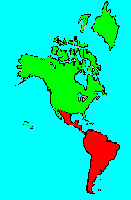SPECIES INFO
The Borhyaena was a somewhat large up to 5 feet in length bear like creature with a long tail. This bear creature lived in southern South America. This bear was probably both a hunter and a scavenger.The Borhyaenidae family evolved in South America probably from opossum like animals. Although some members of this family were smaller than cats, some giants were as large as today's largest bears. These were mostly carnivores with somewhat short legs. These animals lived about 20 to 30 million years ago.
Marsupials (Order Marsupiala) previously was a large order containing numerous extinct, New World, Old World, and Australian species. Recent research indicates that many of the Australian (and New Guinea) marsupials are so diverse that they deserved their own orders. Consequently, patience is required to understand the new taxonomy which contains several new Australian (Marsupial like) orders.
Marsupials (Order Marsupiala) are a very ancient group of mammals that emerged at the end of the Mesozoic. They are the original mammalian fauna of the Australian region where most of this order are found. They are more advanced than the monotremes, differing in anatomy and physiology as well as in the fact that they give birth to young formed within the mother's body (viviparous). Members are characterized by having a pouch to hold the newly born underdeveloped young.
This group of mammals is unusual in that it contains a great variety of forms. There are mouselike animals, kangaroos, the familiar opossum, a wolf-like creature (Tasmanian Wolf, seemingly recently extinct), and an unusual creature called the Tasmanian Devil that has habits like a primitive carnivore.
Marsupials contain examples of a biological theory called convergent evolution. The fact that the Marsupials could develop a wolf-like creature very similar in habits and shape to the North American wolf shows that certain life forms are stable in certain environments.
Several prehistoric marsupials are worthy of mention. The Thylacosmilus genus of South America contained a large species of cat-like carnivore that looked like a saber-toothed tiger and was the size of a jaguar. Thylacoleo was a marsupial lion that became extinct perhaps just 40,000 years ago.
After the removal of the new Australian orders, the remaining marsupial order, usually referred to as the Didelphimorphia order, has 87 species spread among 17 different genera.
Mammals (Class Mammalia), together with the birds, are among the youngest of the classes of animals. In species count, mammals number about fifty-one hundred, trailing reptiles (approximately fifty-five hundred), fish (approximately eighteen thousand), and birds (approximately eighty-six hundred).
There are three sub-types of mammals:
monotremes, the most primitive:
Develop in reptilian-like eggs and suckle milk emerging
(i.e., spiny anteater, duckbilled platypus)
marsupials
Newborn emerges very underdeveloped and continue to
mature in a pouch on its mother's abdomen (i.e., opossums,
koala, kangaroo)
placental
Embryo develops within the uterus of the female and is
dependent on a placenta for nutrition and waste removal
(i.e., humans, lions, monkeys)
About sixty-five million years ago, the Tertiary era produced thirty-five orders of mammals. Of this number, eighteen have survived to represent Earth's most diversified as well as its most highly developed classification of animals.
Extinction of mammals is fast becoming a serious issue. Duff and Lawson present a list of forty-one extinct species that reached extinction prior to 1800. These forty-one species are not acknowledged in the counts of the various families. Duff and Lawson also present a list of forty-six species including three gazelles, one zebra, one seal, one deer, and one wolf that have probably gone extinct since 1800. These forty-six species are included in the family counts. Science is adding about forty to fifty new species a year to the list. Many of these are the result of divisions of prior species; some are recent discoveries.
Mammals owe their survival to adaptive capabilities that include the ability to exploit whatever sources of food are available to them, as well as their ability to adjust to various climes. Food specialization influenced evolution to such a great extent that the teeth structure can and has been used to provide extensive information on the food needs and various lifestyles of extinct species.
Despite the vast diversity among mammals in terms of size, habitats and adaptations, they share without exception many characteristics such as:
a. body hair
b. mammary glands
c. certain skull characteristics
d. four limbs that permit speed
e. parallel not perpendicular limbs
f. compartmentalized internal organs
g. a four-chambered heart and pulmonary circulation
Backboned Animals (Phylum Chordata) are the most advanced group of animals on earth. These animals are characterized by having a spinal cord or backbone. Most members have a clearly defined brain that controls the organism through a spinal cord. Fish, amphibians, reptiles, birds, and mammals are in this phylum.
Currently, some taxonomists believe that the fish should be divided into two groups (sharks and regular fishes) and that there are some other primitive groups in the phylum such as hagfish or lampreys.
Animal Kingdom contains numerous organisms that feed on other animals or plants. Included in the animal kingdom are the lower marine invertebrates such as sponges and corals, the jointed legged animals such as insects and spiders, and the backboned animals such as fish, amphibians, reptiles, birds, and mammals.

